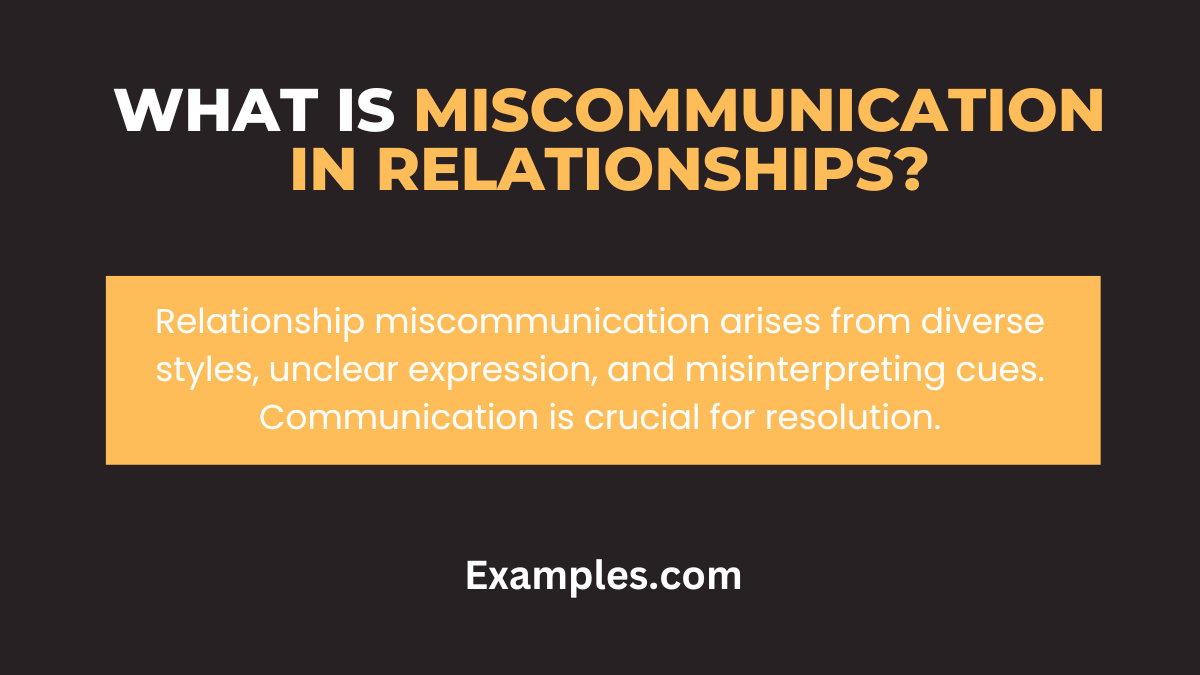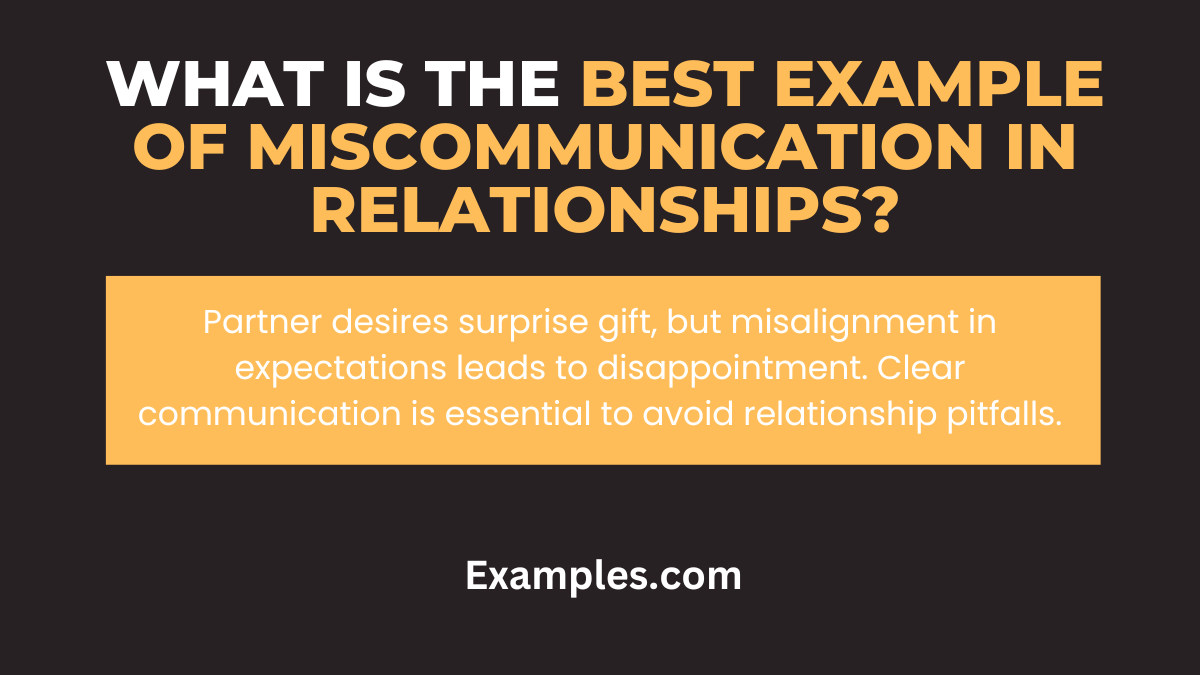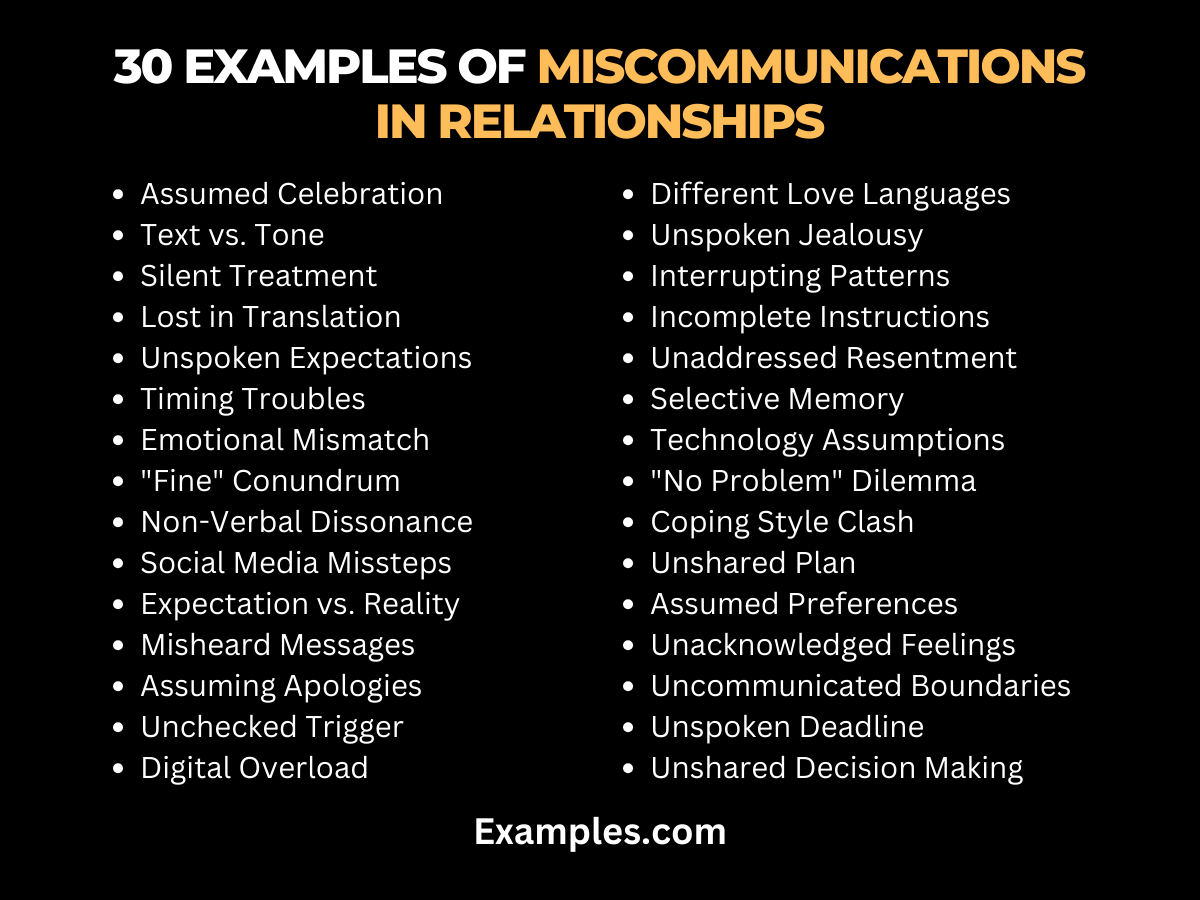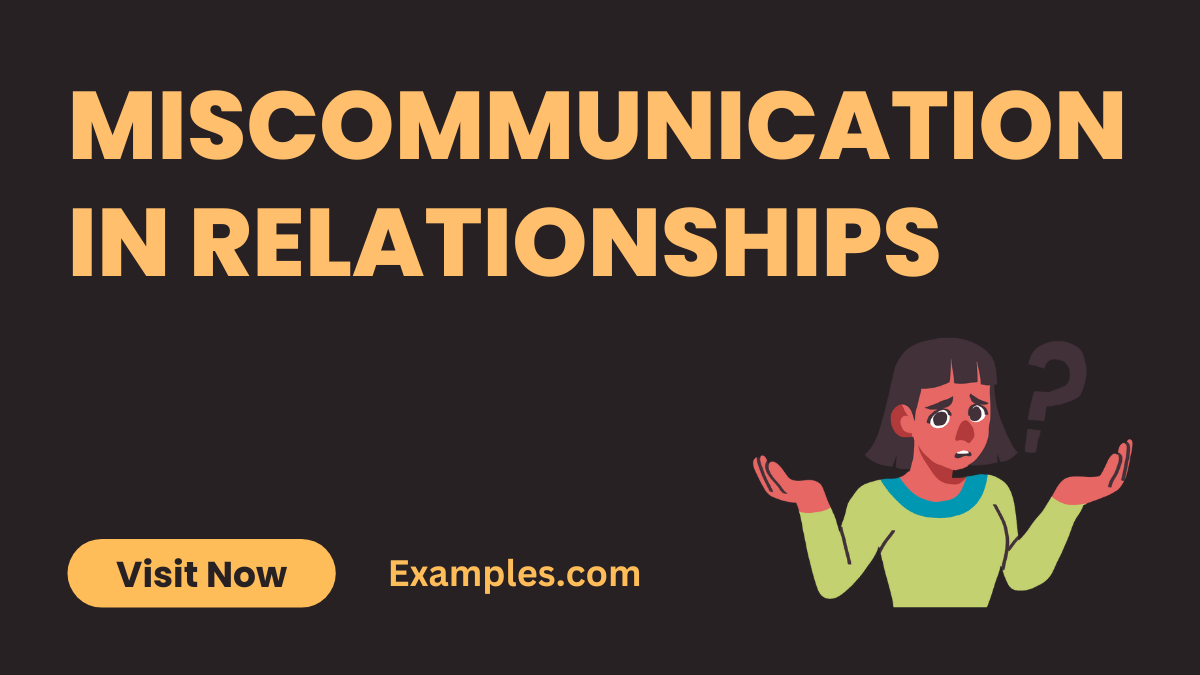29+ Miscommunication in Relationships Examples
Embark on a comprehensive exploration of miscommunication in relationships with our complete guide. Uncover real-life communication examples illustrating common pitfalls and challenges. This resource is meticulously crafted to provide insights, practical solutions, and a deeper understanding of relationship dynamics. Learn to navigate the intricacies of communication with our expert tips, fostering stronger connections and preventing misunderstandings. Discover the power of effective communication and enrich your relationship journey. Welcome to the ultimate guide on miscommunication and communication examples in relationships.
What is Miscommunication in Relationships?

Miscommunication in relationships occurs when partners fail to understand each other’s thoughts, feelings, or intentions. This breakdown in understanding can lead to confusion, conflict, and emotional distress. It often involves the misinterpretation of verbal and non-verbal cues, resulting in communication gaps. Recognizing and addressing miscommunication is crucial for fostering healthy relationships. Clear and open communication is key to building trust, resolving conflicts, and creating a strong foundation for lasting connections.
What is the best Example of Miscommunication in Relationships?

In this illustrative example of miscommunication in relationships, consider a scenario where one partner expresses a desire for a surprise gift. The other, intending to impress, selects what they believe is a thoughtful present. However, the recipient, expecting something entirely different, feels disappointed. Here, the misalignment in expectations and unspoken assumptions leads to a prime example of miscommunication, emphasizing the importance of clear and explicit communication in avoiding such pitfalls in relationships.
30 Miscommunications in Relationships

Explore 30 instances of miscommunication in relationships in this insightful guide. Delve into real-life scenarios, unraveling the complexities of misunderstandings. Gain valuable insights and practical solutions to strengthen your communication skills and fortify your relationship foundation. This comprehensive resource is designed to enhance understanding, promote empathy, and pave the way for more meaningful connections.
- The Assumed Celebration:
- Issue: Assuming a partner’s knowledge of an important date.
- Solution: Clearly communicate expectations and celebrate key dates together.
- Text vs. Tone:
- Issue: Misinterpreting the tone of a text message.
- Solution: Use emojis for clarity or opt for a call for nuanced conversations.
- The Silent Treatment:
- Issue: Using silence as a form of communication.
- Solution: Encourage open dialogue and express feelings openly.
- Lost in Translation:
- Issue: Misunderstanding cultural differences.
- Solution: Learn and appreciate each other’s cultural nuances.
- Unspoken Expectations:
- Issue: Assuming the partner can read minds.
- Solution: Clearly communicate expectations and desires.
- Timing Troubles:
- Issue: Discussing important matters at the wrong time.
- Solution: Choose appropriate moments for crucial conversations.
- Emotional Mismatch:
- Issue: Differing emotional responses to a situation.
- Solution: Acknowledge each other’s feelings and find common ground.
- The “Fine” Conundrum:
- Issue: Saying “fine” when not truly okay.
- Solution: Encourage open communication and honesty.
- Non-Verbal Dissonance:
- Issue: Conflicting non-verbal cues.
- Solution: Discuss and understand each other’s body language.
- Social Media Missteps:
- Issue: Misinterpreting online interactions.
- Solution: Communicate openly about social media boundaries.
- Expectation vs Reality:
- Issue: Expecting grand gestures without communication.
- Solution: Discuss love languages and express desires openly.
- Misheard Messages:
- Issue: Misunderstanding due to unclear communication.
- Solution: Repeat and clarify important information for accuracy.
- Assuming Apologies:
- Issue: Assuming the partner understands the need for an apology.
- Solution: Clearly communicate feelings and seek mutual understanding.
- The Unchecked Trigger:
- Issue: Reacting to unresolved past issues.
- Solution: Address triggers calmly and discuss their origins.
- Digital Overload:
- Issue: Relying solely on digital communication.
- Solution: Balance digital and face-to-face communication for depth.
- Different Love Languages:
- Issue: Expressing love in ways the partner doesn’t recognize.
- Solution: Learn each other’s love languages and adapt.
- The Unspoken Jealousy:
- Issue: Silent jealousy causing tension.
- Solution: Discuss insecurities openly and work on trust.
- Interrupting Patterns:
- Issue: Frequent interruptions during conversations.
- Solution: Practice active listening and take turns speaking.
- Incomplete Instructions:
- Issue: Providing unclear instructions.
- Solution: Be specific and encourage questions for clarity.
- Unaddressed Resentment:
- Issue: Holding onto past resentments.
- Solution: Communicate grievances and work towards resolution.
- Selective Memory:
- Issue: Remembering details inaccurately.
- Solution: Confirm details together to avoid misunderstandings.
- Technology Assumptions:
- Issue: Assuming the partner understands technology.
- Solution: Offer assistance and explain tech-related matters.
- The “No Problem” Dilemma:
- Issue: Saying “no problem” when it is a problem.
- Solution: Encourage open communication about concerns.
- Coping Style Clash:
- Issue: Differing coping mechanisms during stress.
- Solution: Understand each other’s coping styles and provide support.
- The Unshared Plan:
- Issue: Making plans without informing the partner.
- Solution: Discuss plans together to avoid surprises.
- Assumed Preferences:
- Issue: Assuming the partner’s likes and dislikes.
- Solution: Communicate preferences and be open to adjustments.
- The Unacknowledged Feelings:
- Issue: Neglecting to acknowledge the partner’s feelings.
- Solution: Show empathy and validate each other’s emotions.
- Uncommunicative Boundaries:
- Issue: Failing to establish and communicate personal boundaries.
- Solution: Discuss boundaries openly and respect each other’s limits.
- The Unspoken Deadline:
- Issue: Expecting a task to be completed without communication.
- Solution: Discuss timelines and expectations for shared responsibilities.
- Unshared Decision Making:
- Issue: Making significant decisions without consulting the partner.
- Solution: Collaborate on decisions and ensure both voices are heard.
How do you stop miscommunication in a relationship?
Introduction: Explore the nuances of miscommunication in relationships, acknowledging its impact on interpersonal dynamics. This guide delves into the intricacies of why miscommunication occurs and provides actionable insights to foster clearer connections.
1. The Nature of Miscommunication: Uncover the various forms miscommunication can take in relationships. From verbal misunderstandings to non-verbal cues, gain insights into the complex nature of communication breakdowns.
2. Impact on Relationship Dynamics: Examine the repercussions of miscommunication on relationships. Understand how unresolved misunderstandings can lead to conflicts, erode trust, and impact overall relationship satisfaction.
3. Recognizing Common Communication Pitfalls: Identify prevalent communication pitfalls that contribute to miscommunication. From assumptions and unexpressed expectations to different communication styles, explore the factors that can hinder effective dialogue.
4. The Role of Active Listening: Highlight the importance of active listening in preventing miscommunication. Learn how attentive listening, paraphrasing, and clarifying can enhance understanding and create a foundation for healthier communication.
5. Strategies to Prevent Miscommunication: Provide actionable strategies to stop miscommunication before it occurs. From setting clear expectations to cultivating empathy, empower individuals with practical approaches to foster effective communication.
6. Navigating Emotional Factors: Explore the impact of emotions on communication and relationships. Discuss ways to manage strong emotions constructively, promoting a more open and empathetic exchange of thoughts and feelings.
7. Addressing Fear of Confrontation: Examine the fear of confrontation as a barrier to effective communication. Provide guidance on creating a safe space for open dialogue, encouraging partners to express concerns without fear of judgment.
8. Case Studies in Successful Communication: Illustrate successful communication in relationships through real-world examples. Analyze how couples overcome challenges, demonstrating effective strategies that lead to clearer understanding and stronger connections.
9. Building a Culture of Open Communication: Explore the concept of cultivating open communication as a shared responsibility. Discuss the benefits of creating an environment where partners feel comfortable expressing thoughts, feelings, and concerns.
10. Seeking Professional Support: Acknowledge the role of professional help in resolving communication issues. Provide guidance on when and how to seek couples therapy or counseling to navigate complex communication challenges.
Conclusion: Summarize the key takeaways from the guide, emphasizing the proactive measures individuals can take to prevent miscommunication and build stronger, more resilient relationships.
Reasons for Miscommunication in a Relationship
Embark on a journey to understand the intricate web of miscommunication in relationships. Explore the underlying reasons behind communication breakdowns and discover strategies for fostering clarity and connection.
1. Assumptions and Expectations: Delve into how assumptions and unexpressed expectations can lead to misunderstandings. Learn to communicate openly to bridge the gap between assumed knowledge and actual understanding.
2. Different Communication Styles: Explore the impact of varied communication styles within a relationship. Recognize the nuances of individual preferences and find common ground to enhance mutual understanding.
3. Lack of Active Listening: Understand the role of active listening in preventing miscommunication. Learn techniques to engage in meaningful conversations, fostering a deeper connection with your partner.
4. Non-Verbal Cues and Body Language: Unpack the significance of non-verbal cues in communication. Explore how misinterpretation of body language and facial expressions can contribute to relationship misunderstandings.
5. Emotional Factors: Navigate the influence of emotions on communication. Learn to manage and express emotions effectively, creating a space for open and constructive dialogue.
6. Fear of Confrontation: Examine the impact of avoiding difficult conversations. Understand the importance of facing issues head-on to promote transparency and resolution in the relationship.
7. Unexpressed Feelings and Desires: Explore how unspoken feelings and desires can create communication gaps. Learn techniques for expressing emotions and desires in a healthy and constructive manner.
8. Past Baggage and Triggers: Understand how past experiences and unresolved issues can affect current communication. Explore strategies for addressing past baggage to foster a healthier communication environment.
9. External Stressors and Timing: Delve into the role of external stressors and timing in relationship communication. Learn to choose optimal moments for important discussions and manage external pressures.
10. Lack of Clarity in Communication: Explore the importance of clear and precise communication. Understand how vague or ambiguous language can lead to misunderstandings and discover methods for enhancing clarity.
Conclusion: Wrap up this comprehensive guide by emphasizing the importance of proactive communication in overcoming miscommunication hurdles. Empower yourself with the knowledge and tools to build stronger, more resilient relationships through effective communication.
How can I improve relationship communication?
Improving relationship communication is crucial for fostering understanding, trust, and connection. Here are practical tips to enhance communication in your relationships:
- Active Listening:
- Practice active listening by fully focusing on what your partner is saying.
- Avoid interrupting, and provide feedback to demonstrate that you understand.
- Express Yourself Clearly:
- Use clear and concise language to convey your thoughts and feelings.
- Be specific about your needs, expectations, and desires.
- Use “I” Statements:
- Frame your statements using “I” to express your feelings without sounding accusatory.
- For example, say “I feel” instead of “You always.”
- Non-Verbal Communication:
- Pay attention to body language, tone of voice, and facial expressions.
- Ensure your non-verbal cues align with your intended message.
- Ask Open-Ended Questions:
- Encourage deeper conversations by asking open-ended questions.
- This promotes a more meaningful exchange of thoughts and feelings.
- Empathy and Understanding:
- Put yourself in your partner’s shoes to understand their perspective.
- Show empathy by acknowledging their feelings, even if you don’t necessarily agree.
- Be Mindful of Timing:
- Choose appropriate times for important conversations.
- Avoid discussing sensitive topics during times of stress or when either of you is busy.
- Limit Distractions:
- Minimize distractions during conversations, such as phones or television.
- Give each other your undivided attention to strengthen the quality of communication.
- Couples Counseling:
- Consider couples counseling to work on communication with the guidance of a professional.
- A therapist can offer tools and strategies to improve your communication dynamics.
- Regular Check-Ins:
- Schedule regular check-ins to discuss the state of the relationship.
- This allows you to address concerns and celebrate achievements together.
- Learn Each Other’s Love Languages:
- Understand your partner’s love language and communicate in ways that resonate with them.
- This fosters a deeper emotional connection.
- Be Open to Feedback:
- Create an environment where both partners feel comfortable giving and receiving feedback.
- Constructive feedback can help you both grow and improve communication.
- Apologize and Forgive:
- Apologize when necessary and forgive each other for mistakes.
- Holding onto grudges can hinder effective communication.
- Establish Clear Boundaries:
- Discuss and establish boundaries within the relationship.
- Clearly communicate what is acceptable and unacceptable in terms of behavior.
- Celebrate Achievements:
- Acknowledge and celebrate each other’s accomplishments and milestones.
- Positive communication builds a supportive and uplifting atmosphere.
Improving communication is an ongoing process that requires effort from both partners. By incorporating these strategies into your relationship, you can create a foundation for healthy and effective communication.
How Miss Communication breaks Relationship?
Miscommunication can significantly impact relationships, leading to misunderstandings, frustration, and even the deterioration of the connection between partners. Here are ways in which miscommunication can break a relationship:
- Builds Resentment:Miscommunication may lead to unmet expectations and unexpressed feelings, fostering resentment over time.
- Erodes Trust:When partners feel misunderstood or perceive dishonesty due to miscommunication, trust can be undermined.
- Creates Emotional Distance:Constant miscommunication can lead to emotional disconnection, causing partners to feel distant and detached.
- Increases Conflict:Misunderstandings can escalate into conflicts when communication breaks down, leading to arguments and disputes.
- Leads to Assumptions:Miscommunication often involves making assumptions about the partner’s thoughts or intentions, leading to confusion and potential conflict.
- Causes Emotional Pain:Words and actions based on miscommunication can cause emotional pain and distress, negatively affecting the emotional well-being of both partners.
- Limits Intimacy:Lack of clear communication can hinder emotional intimacy and closeness between partners, making it difficult to connect on a deeper level.
- Hampers Problem-Solving:Effective communication is essential for resolving issues and conflicts. Miscommunication can impede problem-solving, leaving problems unresolved.
- Encourages Withholding:Partners may start withholding thoughts or emotions if they fear being misunderstood, creating a barrier to open communication.
- Diminishes Connection:A breakdown in communication diminishes the overall connection between partners, making it challenging to maintain a strong and healthy relationship.
- Fosters Insecurity:Miscommunication can create feelings of insecurity as partners may question the reliability and authenticity of the information exchanged.
- Contributes to Loneliness:Feeling misunderstood or not heard can lead to emotional loneliness within the relationship, even if partners are physically together.
- Impacts Decision-Making:Miscommunication can lead to decisions based on incomplete or inaccurate information, affecting the overall well-being of the relationship.
- Diminishes Satisfaction:When communication is consistently unclear or problematic, overall relationship satisfaction can decrease.
- Increases Stress:The stress of miscommunication can accumulate over time, affecting both partners’ mental and emotional health.
To mitigate the negative impact of miscommunication, it’s essential for partners to actively work on improving communication skills, fostering openness, and creating an environment where both individuals feel heard and understood. Regular check-ins, honest conversations, and a commitment to clear communication are key elements in building and maintaining a healthy and thriving relationship.



